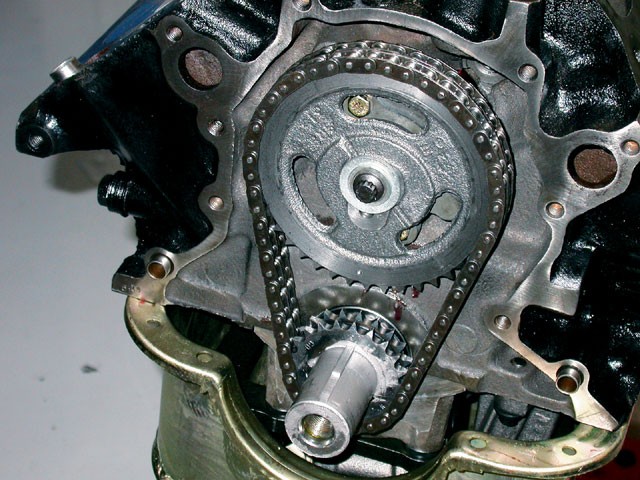How to identify a Bad or Failing Timing Chain
The most common signs of a faulty timing chain are engine misfires, metal shavings in the oil, and rattling noises from the engine while idling.
by David Williams September 5, 2021

Since the inception of the internal combustion engine, one constant has remained – all of them have a timing chain or timing belt. Most higher-displacement engines have a timing chain as opposed to a timing belt. The chain is located in the front of the motor and is attached to a set of gears and pulleys that power multiple mechanical components, including the crankshaft and camshaft. In order for your engine to fire, the timing chain must smoothly rotate around the gears without hesitation. Although the timing chain is made out of metal, it is subject to wear and tear and may break if not replaced as recommended by the manufacturer.
The timing chain is comprised of a series of links in the chain – similar to those found on a bicycle chain. The links move on the toothed sprockets which are located on the ends of the crankshaft and camshaft and are responsible for opening and closing valves in the cylinder head and moving pistons and connecting rods in the combustion chamber. The timing chain can start to stretch and wear over time, which will cause the engine's timing to be inaccurate and produce a few warning signs.
The following are 5 symptoms of a worn out timing chain. If you notice any of these warning signs, contact a local mechanic to diagnose the exact cause and make any necessary repairs.
1.Engine misfires or runs poorly
There are two ways to achieve valve timing in a combustion engine. The first is the two-gear method, which includes the crankshaft to camshaft gear direct connection. This is the method used in most types of heavy equipment and big trucks. The timing chain method is more common with consumer vehicles and high-performance engines. Over a period of time, the timing chain can stretch, which can cause the chain to skip a gear on the cam or crankshaft. This causes the engine’s timing to fall out of calibration and often results in a misfire. The engine may also run poorly and lack accelerating power.
If this situation occurs, it's likely the timing chain is damaged and needs to be replaced as soon as possible. If the timing chain breaks, the loose metal rolling around inside the motor can lead to serious engine damage.
2.Metal shavings found in the oil
It's recommended by all automotive manufacturers to change the engine oil and filter every 3,000 to 5,000 miles. Over time, oil begins to separate as it heats up and is exposed to natural solvents found in gasoline. If the timing chain begins to wear out, small metal pieces can break off the chain and find their way into the oil pan. When you have your oil changed, and the mechanic tells you there were small pieces of metal inside the oil as it drained or in the filter, it's a good indication that your timing chain is beginning to fail.
Metal shavings are also commonly seen when there is extensive wear of cylinder head valves, keepers, retainers and other cylinder head hardware. It’s crucial to have a mechanic or technician inspect this issue and make the appropriate repairs as soon as possible.
3.Engine won’t start or fails
A broken timing chain will cause an engine to not start or fail while driving. If the belt is already broken, the engine won’t have enough compression to start. If it breaks or jumps while driving, the pistons will be damaged from contact with the valves. The valves themselves will bend and potentially ruin the engine. If the belt is jumping because it’s gotten loose, it can also flail around and damage other parts of the engine. If your engine won’t start or starts driving rough, indicating it may be on its way to failing, contact a certified mechanic for inspection and repairs.
4.Check Engine Light is on
The check engine light can illuminate for a variety of reasons, one of which could be a failing timing chain. A car’s computer will display warning lights that must be checked and scanned for trouble codes to determine the source of the issue. The check engine light may turn on when the onboard computer detects something wrong with the emissions system and engine operation. A stretched timing chain contributes to poor engine performance and increased emissions, triggering the check engine light and the storing of a diagnostic trouble code. A mechanic will need to inspect the code and prescribe the necessary repairs.
5.Engine rattles while idling
Unusual sounds are also a common warning sign of a problem inside your motor. Under normal conditions, the engine should have a consistent, smooth sound indicating everything is running as it should. However, when the timing chain is loose, it may cause a vibration inside the motor and that will produce a rattling noise as the engine idles. Anytime you hear a rattle it means something is loose and needs to be fixed before it breaks.
The timing chain is an integral part of any engine, and without it, your vehicle is rendered useless. If the timing chain breaks while you are driving, serious damage to your vehicle's engine is probable. The best way to reduce the potential for serious engine damage is to have a professional mechanic replace your timing chain if you notice any of these warning signs listed above. By being proactive and alert, you can save thousands of dollars and significantly extend the life of your engine.













